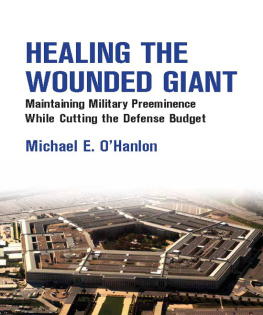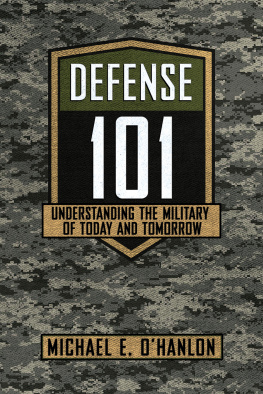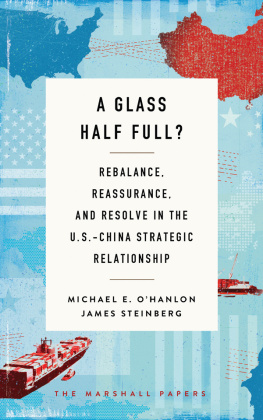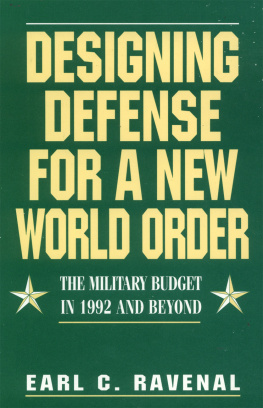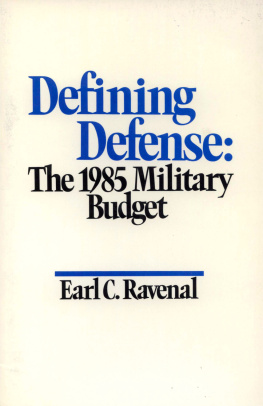PREFACE
How much more should defense spending be cut, if at all, as part of further deficit reduction efforts in the United States? This is a central question as Congress and the president seek to avoid future fiscal calamities while finding a balanced, politically acceptable path toward deficit reduction.
The cuts initially mandated from the 2011 Budget Control Act are often described as costing the armed forces $487 billion over ten years, relative to the plan that existed before that deal was passed. In fact, it is more accurate to describe those cuts as totaling $350 billion, since that is the total when the current defense plan is measured relative to a standard Congressional Budget Office baseline that assumes only adjustments for inflation into the future. Savings from reduced war spending are even larger, and additional to the $350 billion figurethough, of course, that spending was never intended to be permanent and as such should be analyzed separately.
Should it remain in place, the March 2013 sequestration, like the recommendations of the Simpson-Bowles and Rivlin-Domenici deficit reduction commissions of 2010, would cut roughly another $500 billion from defense spending levels over the next ten years.
The Obama administration's military plan, as published in early 2012, now incorporates the assumed cuts from the first round of the Budget Control Actthe $350 billion noted above. It does not include cuts from sequestration. The current administration plan will scale down the military from about 1.5 million active-duty uniformed personnel to its pre-9/11 total of 1.4 million, or two-thirds the cold war norm. It chips away at modernization programs but preserves most major ones, with one or two notable exceptions. It levels off various forms of military pay and benefits. But most troops will continue to be compensated better than private-sector cohorts of similar age, education, and technical skill. The Obama plan also holds out ambitious hopes for efficiencies from various vaguely specified reforms projected to save $60 billion over a decade, and it assumes, again optimistically, that weapons systems will be delivered at currently projected costs. Overall, the 2012 Obama plan amounts to a serious belt tightening, rather than fundamental strategic or military change.
Conceptually, the Obama approach is built on time-tested principles of American defense policy, modified only modestly in recent years. The Persian Gulf and Western Pacific remain the two principal theaters of overseas concernalthough the administration is seeking to emphasize the broader Middle East/Gulf region somewhat less than in the past and, through its policy of rebalancing, the Pacific somewhat more. A two-war capability of sorts is retained, even if two full-scale simultaneous regional conflicts are assessed as less likely than before, and large-scale stabilization missions are also seen as less likely. Of course, these latter assumptions must be tempered by the fact that possible enemies get a say in our decisions, too. In the short term, force planning must also account for two specific matters of acute concern: the ongoing operation in Afghanistan, where more than 60,000 American troops remain as of early 2013, and possible operations in the coming year or two against Iran's nuclear facilities. Surprises could lurk, too.
Against this backdrop, this book argues that it is possible to imagine additional defense cuts, in weapons and force structure and other expenses, of up to $200 billion over a decade, above and beyond those scheduled in 2012. These savings, however, would be considerably less than envisioned under sequestration or Simpson-Bowles.
Moreover, some of those savings might be counterbalanced by higher-than-expected costs in the Department of Defense (DoD). What this means is that net savings could be less than $200 billion, perhaps by tens of billions of dollarsan important reality to bear in mind in all discussions of future defense reforms. We may need to cut more forces and weapons just to achieve the budget targets already assumed by existing law and policy as of 2012.
My recommendations include the following:
The size of the active-duty Army and Marine Corps could be reduced modestly below their 1990s levels (to, say, 450,000 soldiers and 160,000 Marines); plans as of 2012 are to keep them slightly above those levels. Ten-year savings relative to the administration's 2012 plans could reach about $80 billion.
Rather than increase its fleet, the Navy could employ innovative approaches like sea swap, by which some crews are rotated via airplane while ships stay forward-deployed longer. This idea, and more forward homeporting of attack submarines at Guam, could eventually allow the Navy to get by with 260 to 270 ships rather than 286. Ten-year savings could be $25 billion.
The F-35 joint strike fighter, a good plane but an expensive one, could be scaled back by half from its current intended buy of about 2,500 airframes, at an eventual annual savings of more than $5 billion but with only modest cumulative savings of $10 billion to $20 billion over the coming decade (as some planes should be bought promptly).
Rather than designing a new submarine to carry ballistic missiles, the Navy might simply refurbish the existing Trident submarine or reopen that production line. That and other economies in nuclear forces, including the conversion of Lawrence Livermore National Laboratories away from the nuclear weapons design business, could yield $20 billion in ten-year savings in the national defense budget. Cancellation of a short-range missile defense program could save another $7 billion or so.
Military compensation could be streamlined further as well, despite Congress's recent reluctance to go along with even the modest changes proposed in 2012 by the administration. Stateside commissaries and exchanges might be closed, and military health care premiums increased even more than the administration proposed last year. Military pensions might be reformed too, with somewhat lower payments for working-age military retirees having twenty years or more of service, and introduction of a 401k-like plan for those who never reach twenty years (and currently receive nothing). This could be done in a way that would achieve modest net savings. The combined effects of all these changes could exceed $50 billion over ten years.
Another idea in this vein could save substantial sums, although it would require help from allies and would have to be phased in with time. At present the United States relies almost exclusively on aircraft carriers, each carrying about seventy-two aircraft, to have short-range jets in position for possible conflict with Iran. Over the past decade, land-based combat jets formerly based in Saudi Arabia, Kuwait, and Iraq have largely come home. While the United States occasionally rotates fighter jets through the small states of the Gulf Cooperation Council, and while it maintains command and control and support assets in states like Qatar and the United Arab Emirates, permanent ashore combat power is very limited. By seeking two or more places to station Air Force combat jets continuously in Gulf states, the United States could facilitate a reduction of one or two carrier battle groups in its fleet. (In theory, it could cut the aircraft carrier fleet even more this way, since the Navy currently needs about five carriers in the fleet to sustain one always on station. But the unpredictabilities of such foreign basing counsel a more hedged approachfor example, if Gulf states refused permission, the United States might need to surge carriers temporarily even under this plan to conduct offensive operations against Iranian nuclear facilities.) Cutting two aircraft carrier battle groups and associated aircraft could save perhaps $50 billion over a decade, since this option would take time to implement even if regional allies quickly approve it.

